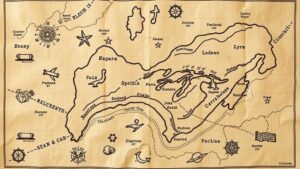Using Temperature Variations to Detect Hidden Shipwreck Artifacts
Using Temperature Variations to Detect Hidden Shipwreck Artifacts
The study of shipwrecks has fascinated archaeologists and marine scientists for centuries. As submerged vessels often carry cultural, historical, and economic significance, the ability to detect hidden artifacts associated with these wrecks is crucial. One innovative approach to locating such artifacts involves analyzing temperature variations in underwater environments. This article delves into the methodologies, findings, and implications of using thermal detection techniques in maritime archaeology.
The Science Behind Temperature Variation
Temperature variation plays a vital role in underwater research, largely due to the physical properties of water and the materials used in shipbuilding. When a shipwreck occurs, the vessel and its contents interact with their environment in unique ways, creating temperature anomalies. These anomalies can be detected through various means, offering clues about hidden artifacts and the wreck itself.
Water has a high specific heat capacity, meaning it can maintain stable temperatures, but artifacts, wood, metals, and other materials often heat and cool at different rates compared to their environment. e discrepancies can be detected using thermal imaging technology.
Methodologies in Temperature Detection
Modern maritime exploration employs advanced technologies to measure temperature variations effectively. Some of these methods include:
- Infrared Thermal Cameras: These devices capture infrared radiation emitted by objects, thus revealing temperature differences even in murky waters.
- Remote Sensing: Satellite or aerial imagery can be employed to survey large areas for potential shipwreck sites based on thermal anomalies.
- Submersibles and ROVs: Remotely operated vehicles equipped with thermal sensors can navigate deep underwater, providing detailed imagery and data collection.
For example, the research conducted on the sunken Spanish galleon Nuestra Señora de Atocha demonstrated the efficacy of thermal imaging techniques. After performing thermographic surveys in the vicinity of the wreck, researchers identified temperature anomalies that guided subsequent excavation efforts.
Case Studies: Successful Applications
The application of thermal detection methods extends beyond theoretical strategies; several successful case studies illustrate their practical utility in uncovering hidden artifacts. Noteworthy examples include:
- The Titanic Expedition: During deep-sea explorations, researchers employed thermal imaging to detect debris fields surrounding the wreck, uncovering forgotten artifacts that held historical importance.
- The Battle of the Atlantic: Investigations into WWII-era submarine wrecks utilized temperature measurements to locate hidden torpedoes and ammunition, providing insights into historical naval strategies.
In both cases, the utilization of temperature variations not only facilitated the discovery of artifacts but also contributed significantly to historical narratives regarding shipwrecks.
Challenges and Limitations
Despite its advantages, utilizing temperature variations for artifact detection comes with challenges. Environmental factors such as water currents, thermal stratification, and the presence of marine life can affect temperature readings. Also, the technology involved requires extensive calibration and validation to ensure accuracy.
Plus, the physical location of shipwrecks can complicate data interpretation. Shipwrecks buried beneath sediment may not produce significant temperature shifts, rendering thermal imaging less effective. As such, researchers often employ a multimodal approach, combining thermal detection with sonar mapping and underwater excavation techniques.
Future Directions and Innovations
The continuing advancements in technology signal promising future directions for the integration of temperature variation detection in maritime archaeology. The advancements in sensor technology and artificial intelligence can enhance the sensitivity of thermal imaging, allowing for more nuanced interpretations of temperature data.
Also, collaborative efforts among marine archaeologists, data scientists, and engineers will foster the development of sophisticated algorithms that can predict artifact locations based on previously collected thermal data. Such innovations may increase efficiency in archaeological dives and lead to the discovery of previously overlooked wrecks.
Conclusion
In summary, using temperature variations to detect hidden shipwreck artifacts presents a unique intersection of technology and archaeology. As this method continues to evolve, its potential for uncovering significant historical artifacts grows, fostering a deeper understanding of maritime history.
For those involved in naval archaeology, this technology highlights a pivotal shift in how hidden artifacts are discovered and preserved. Useing these techniques not only aids in uncovering treasures of the past but also promotes the conservation of underwater cultural heritage for future generations.
As the field advances, embracing these innovative approaches will be essential for researchers aiming to deepen their understanding of our maritime heritage.



